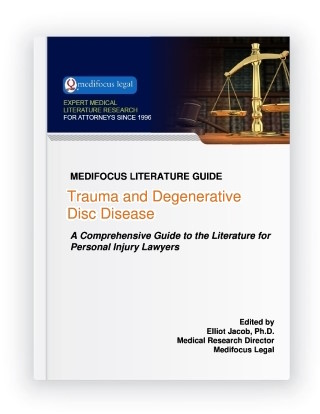Trauma and Degenerative Disc DiseaseA Comprehensive Guide to the Literature for Personal Injury Lawyers
Publisher: Medifocus Legal
Publication Date: November 26, 2025
Number of Pages: 129
A Comprehensive Guide to the Literature for Personal Injury Lawyers
Publisher: Medifocus LegalPublication Date: November 26, 2025
Number of Pages: 129
During a collision, the body experiences sudden and intense forces that can exceed the normal load-bearing capacity of the spine. This can result in compression, torsion, or shearing forces being exerted on the spine. Furthermore, trauma can also disrupt the balance of forces within the spine, leading to abnormal loading patterns on the vertebrae and discs. This can accelerate the degeneration process by causing uneven wear and tear on the discs, leading to the development of osteophytes or bone spurs, which further compromise the stability of the spine.
Studies have demonstrated that spinal trauma can also trigger inflammation in the tissues surrounding the intervertebral discs. Inflammation is known to play a role in the degeneration process of the spine by promoting the breakdown and repair of the extracellular matrix - a large network of proteins and other molecules that surround, support, and give structure to cells and tissues. Moreover, chronic inflammation resulting from trauma may contribute to progressive degeneration of the spine.
Proving legal causation in cases involving a claim of spinal disc degeneration resulting from trauma can be challenging due to the high prevalence of pre-existing disc degeneration in the adult general population. It's been estimated that by the age of 60, more than 90% of people will show evidence of some disc degeneration. Plaintiffs face the challenge of establishing a clear causal link between the trauma and the disc degeneration, while defendants will seek to undermine this connection by highlighting alternative explanations, such as normal age-related "wear and tear" for the degeneration. At this point, the outcome of these cases often hinges on a battle between opposing experts.
We've searched the medical literature and compiled a comprehensive guide to clinical and scientific studies published over the past two decades that focus on the role of trauma in the development of degenerative disc disease. This peer reviewed literature can play a crucial role when it comes to litigating cases involving a claim that trauma from an accident or a fall either directly caused or exacerbated spinal disc degeneration.
The MediFocus Literature Guide to Trauma and Degenerative Disc Disease is a comprehensive reference guide to the medical literature that is designed to help personal injury lawyers develop an in-depth understanding of the role that trauma plays in the development or exacerbation of disc degeneration. This objective is accomplished by a thorough review of the peer-reviewed medical literature published over the past 15 years as documented from case reports, cohort studies, and major topical review articles.
The MediFocus Literature Guide to Trauma and Degenerative Disc Disease is available both as a soft-cover book and as a PDF download. Order your copy today. Please see the side panel for more information.
 |
- A comprehensive bibliography of 188 journal article references indexed in MEDLINE published in well respected medical and scientific journals.
- Online access to the abstracts (summaries) of the articles.
- Online access to the free full-text version of 40 articles.
- Links to full-text sources of other articles that are available for purchase directly from individual journal publishers.
- A unique "Author Directory" consisting of the names and institutional affiliations of experts who have published and have specialized knowledge about Trauma and Degenerative Disc Disease. The "Author Directory" is a valuable resource for quickly identifying and locating experts for case reviews, opinions, and testimony.
Select examples of topics that are covered by the articles referenced in this Guidebook include:
- The role of back injury or trauma in lumbar disc degeneration: an exposure-discordant twin study.
- The cervical spine of professional front-row rugby players: correlation between degenerative changes and symptoms.
- Morphological changes in the human cervical intervertebral disc post trauma.
- Acute mechanical injury of the human intervertebral disc: link to degeneration and pain.
- Intervertebral disc cell death in the porcine and human injured cervical spine after trauma: a histological and ultrastructural study.
- ACC and back injuries: the relevance of pre-existing asymptomatic conditions revisited.
- Degenerative and traumatic changes in the lower cervical spine facet joints.
- Dynamic bulging of intervertebral discs in the degenerative lumbar spine.
- Trauma induces apoptosis in human thoracolumbar intervertebral discs.
- Morphological cervical disc analysis applied to traumatic and degenerative lesions.
- Trauma induces apoptosis in human thoracolumbar intervertebral discs.
- Injury mechanisms of the cervical intervertebral disc during simulated whiplash.
- Morphological cervical disc analysis applied to traumatic and degenerative lesions.
- Pathophysiology of lumbar disc degeneration: a review of the literature.
- MR imaging of the spine: trauma and degenerative disease.
- Histologic changes in the disc after cervical spine trauma: evidence of disc absorption.
- Radiological case of the month. Post-traumatic degenerative change of the cervical spine.
- Does football cause an increase in degenerative disease of the lumbar spine?
- The prognosis of neck injuries resulting from rear-end vehicle collisions.
- Premature onset of degenerative disease of the cervical spine in rugby players.
is available in two formats: | |
Order by Phone:To order by phone, please call: Order by Mail:To order by mail, please print and complete this Order Form | |

